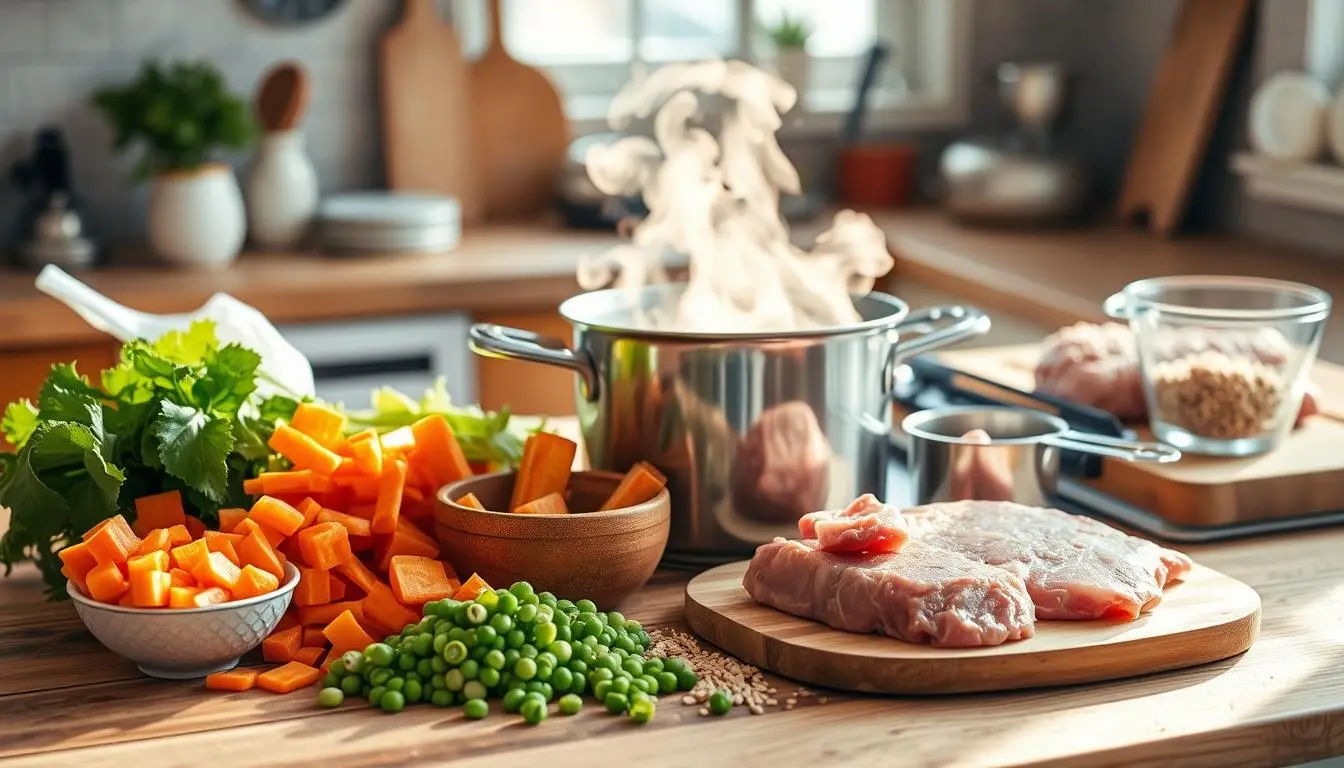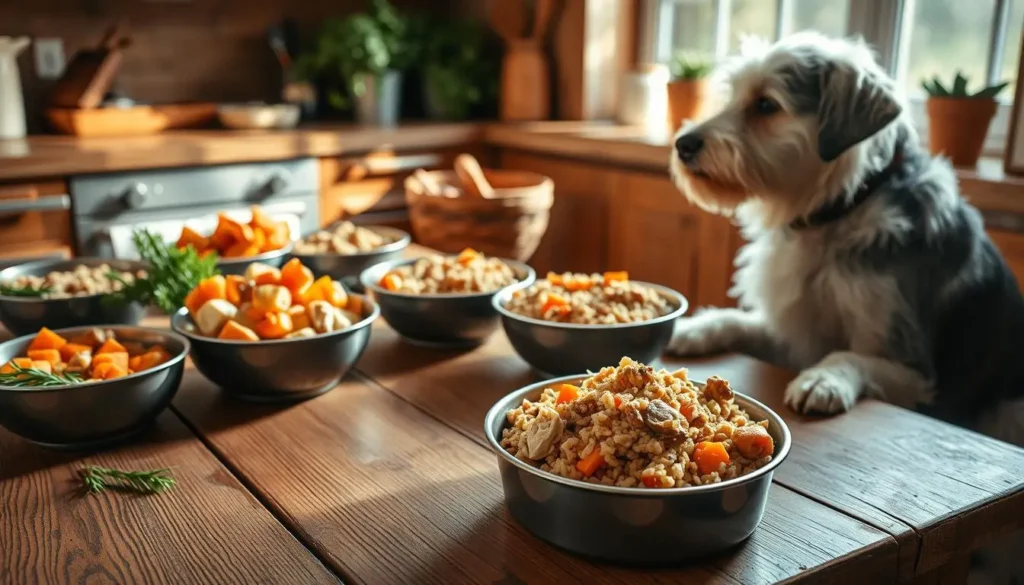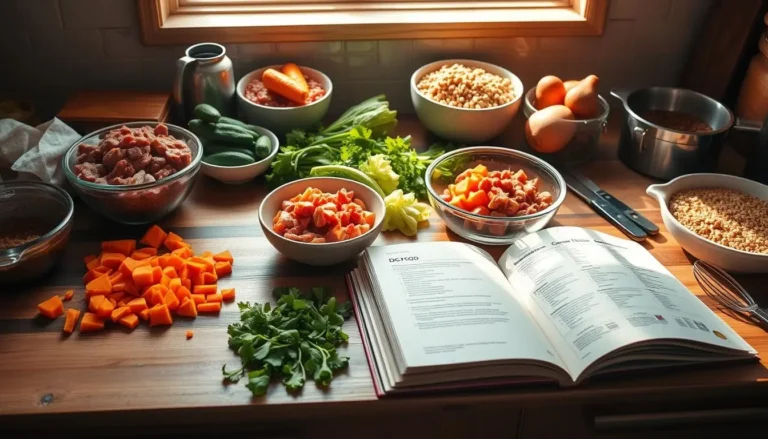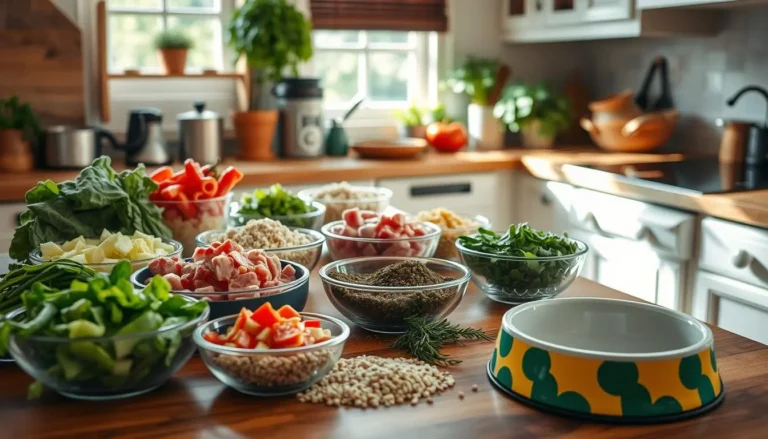How to Make Homemade Dog Food: Easy Recipes and Tips

Feeding your furry friend high-quality nutrition doesn’t have to be expensive. Learning how to make homemade dog food can greatly improve your pet’s diet and health. By making dog food at home, you can ensure your pet gets the best nutrition for their needs.
It might seem hard to prepare dog home food, but with the right help, it’s easy. This guide will teach you everything about making homemade dog food. You’ll learn about nutritional needs and how to make simple, tasty meals for your dog.
Table of Contents
Key Takeaways
- Homemade dog food offers complete control over ingredient quality
- Nutritional balance is crucial for your dog’s health
- Preparing dog food at home can be cost-effective
- Understanding your dog’s specific dietary needs is essential
- Consultation with a veterinary nutritionist is recommended
Benefits of Making Your Own Dog Food at Home
Preparing homemade dog food lets you control your pet’s nutrition. It offers health benefits that commercial brands can’t match.
By making your dog’s meals, you know exactly what they eat. You can tailor their diet to their needs.
Control Over Ingredients and Quality
Homemade dog food means you know where your ingredients come from. You can choose:
- Fresh, high-quality proteins
- Organic vegetables
- Nutrient-rich grains
- Avoid artificial preservatives
Cost-Effectiveness of Homemade Dog Food
| Expense Category | Commercial Food | Homemade Food |
|---|---|---|
| Monthly Cost | $60-$100 | $40-$80 |
| Ingredient Quality | Standard | Premium |
| Customization | Limited | Unlimited |
Health Advantages for Your Pet
Knowing what’s good for your dog lets you create nutrition that:
- Improves digestion
- Boosts energy
- Strengthens the immune system
- Helps maintain a healthy weight
“Nutrition is the cornerstone of your dog’s health. Homemade meals offer a path to optimal wellness.” – Veterinary Nutrition Expert
Remember, every dog is unique. A veterinary nutritionist can help you create the perfect dog food recipe for your pet.
Essential Nutrients Your Dog Needs Daily
Knowing what foods are good for dogs starts with understanding essential nutrients. Dogs need a balanced diet for growth, energy, and health.
Proteins are vital in your dog’s diet. They help build muscles, repair tissues, and boost the immune system. Quality protein sources like lean meats, fish, and eggs are important.
- Proteins: 25-30% of daily diet
- Carbohydrates: 30-50% of daily intake
- Fats: 10-15% of total nutrition
Carbohydrates give dogs energy and fiber. Whole grains, vegetables, and some fruits are great sources. They help with digestion and keep energy levels stable.
“A balanced diet is the foundation of your dog’s health and happiness.” – Veterinary Nutritionist
Vitamins and minerals are key for many body functions. Dogs need specific nutrients for:
- Bone strength
- Immune system
- Metabolic processes
- Skin and coat health
When picking foods for your dog, choose whole, natural ingredients. Each dog is different. Talking to a vet can help make the best diet plan.
Safe and Unsafe Ingredients for Dog Food Preparation
Making healthy dog food at home means picking the right ingredients. Knowing what’s good for dogs is key to their health. The right food can keep them healthy and help them grow.
When making homemade dog food, it’s important to know which foods are good and which are bad. Dogs need certain foods that humans don’t. This is because their diet is different from ours.
Essential Foods to Always Include
- Lean proteins like chicken, turkey, and fish
- Cooked eggs for protein and nutrients
- Sweet potatoes for complex carbohydrates
- Pumpkin for digestive health
- Blueberries as antioxidant-rich treats
Ingredients to Strictly Avoid
- Chocolate and caffeine
- Grapes and raisins
- Onions and garlic
- Macadamia nuts
- Xylitol (artificial sweetener)
Portion Size Guidelines
| Dog Size | Daily Food Amount | Protein Percentage |
|---|---|---|
| Small (10-25 lbs) | 1-1.5 cups | 25-30% |
| Medium (25-50 lbs) | 2-2.5 cups | 30-35% |
| Large (50-90 lbs) | 3-4 cups | 35-40% |
“Nutrition is the foundation of your dog’s health. Choose ingredients wisely.” – Veterinary Nutrition Expert
Remember to introduce new foods gradually and monitor your dog’s response. Each dog is unique and may have individual dietary needs.
How to Make Homemade Dog Food: Basic Steps
Making homemade dog food needs careful planning and attention. First, understand your dog’s nutritional needs. Then, pick high-quality ingredients for a balanced recipe.
- Large mixing bowl
- Sharp kitchen knife
- Cutting board
- Measuring cups
- Storage containers
The main steps for making homemade dog food are:
- Choose lean protein sources
- Select complex carbohydrates
- Add nutrient-rich vegetables
- Include essential supplements
- Cook ingredients thoroughly
“Nutrition is the foundation of your dog’s health. Homemade meals can provide superior quality when prepared correctly.” – Veterinary Nutrition Expert
Creating a balanced dog food recipe needs precision. Consult with a veterinary nutritionist to ensure your homemade meals meet all your dog’s dietary requirements.
| Protein Source | Carbohydrate | Vegetable |
|---|---|---|
| Chicken | Brown Rice | Carrots |
| Turkey | Sweet Potato | Green Beans |
| Lean Beef | Quinoa | Spinach |
When switching to homemade dog food, do it slowly. Mix a little homemade food with their current diet. Gradually increase the homemade food over 7-10 days.
Quick and Easy Dog Food Recipe for Beginners
Making healthy dog food at home is easy. You can make a tasty and nutritious meal for your dog. This will keep them happy and healthy.
By making your dog’s food, you can choose what they eat. Here’s a simple recipe for beginners.
Required Kitchen Tools
- Large mixing bowl
- Measuring cups
- Sharp kitchen knife
- Cutting board
- Large skillet or cooking pot
- Airtight storage containers
Ingredients for Basic Dog Food Recipe
- 2 pounds lean ground turkey
- 1 cup brown rice
- 1 cup mixed vegetables (carrots, peas, sweet potatoes)
- 2 tablespoons olive oil
- 1/2 cup chicken or beef broth
Step-by-Step Cooking Instructions
- Cook ground turkey in a large skillet until fully browned
- Add rice and cook according to package instructions
- Mix in chopped vegetables and broth
- Simmer for 10-15 minutes until vegetables are tender
- Let the dog food recipe cool completely before serving
Storage Tips
Keep your homemade dog food in the fridge for up to 4 days. Freeze individual portions for longer storage. Thaw in the fridge before serving.
“Homemade dog food gives you complete control over your pet’s nutrition.” – Veterinary Nutrition Experts
Pro tip: Always check with your vet before changing your dog’s diet. This ensures it’s right for their needs.
Special Recipes for Senior Dogs

Making homemade dog food for senior dogs needs careful thought. As dogs get older, their metabolism slows down. They also face health issues like joint problems and digestive sensitivities.
“Nutrition is the foundation of health for senior dogs, and a well-planned homemade dog food recipe can make a significant difference in their quality of life.” – Veterinary Nutrition Expert
When making food for senior dogs, keep these nutritional points in mind:
- Lower calorie content to prevent weight gain
- Higher protein quality for muscle maintenance
- Enhanced omega-3 fatty acids for joint health
- Easily digestible ingredients
Here’s a recipe for senior dogs that’s full of nutrients:
| Ingredient | Amount | Benefit |
|---|---|---|
| Lean Chicken | 1 cup | Protein source |
| Sweet Potato | 1/2 cup | Fiber and vitamins |
| Cooked Quinoa | 1/4 cup | Complex carbohydrates |
| Salmon Oil | 1 tsp | Omega-3 fatty acids |
Always consult with your veterinarian before starting a new homemade dog food diet. They can adjust the recipe to fit your dog’s health needs and ensure they get the right nutrition.
When cooking for senior dogs, use gentle methods and avoid too much seasoning. Keep portion sizes the same. Remember, every senior dog is different, so watch how they react to the new food.
Batch Cooking and Proper Storage Methods
Batch cooking homemade dog food saves time and ensures your pet eats well. It’s all about planning and storing food right.
Freezing Guidelines for Homemade Dog Meals
Freezing is a great way to keep your dog’s meals fresh. Here are some tips to keep food quality high:
- Use airtight, freezer-safe containers
- Portion meals into individual servings
- Label containers with preparation date
- Store frozen dog home food for up to 3 months
Meal Prep Schedule
Having a regular meal prep day makes things easier. Pick one day a week for batch cooking:
- Choose a consistent prep day
- Prepare 7-10 days worth of meals
- Rotate protein sources for variety
- Plan around your dog’s nutritional needs
Food Safety Tips
Food safety is very important when making homemade dog food. Remember these tips:
- Always use fresh, high-quality ingredients
- Cook meats thoroughly
- Refrigerate prepared meals promptly
- Thaw frozen meals in the refrigerator
“Proper storage and preparation are key to maintaining the nutritional integrity of homemade dog food.” – Veterinary Nutrition Experts
Using these batch cooking and storage tips helps you provide healthy, home-prepared meals for your dog.
Common Mistakes to Avoid When Making Dog Food

Making homemade dog food needs careful attention. Many pet owners make mistakes that can harm their dogs. These errors can be serious.
“Nutrition is the cornerstone of your dog’s health. One wrong ingredient can make a significant difference.” – Veterinary Nutritionist
When preparing what foods are good for dogs, several common mistakes can compromise your pet’s nutritional needs:
- Nutritional Imbalance: Failing to provide a complete range of essential nutrients
- Incorrect protein-to-carbohydrate ratios
- Overlooking critical vitamin and mineral requirements
- Using potentially toxic ingredients
Key pitfalls to watch out for include:
- Not consulting with a veterinary nutritionist before starting
- Relying on incomplete online recipes
- Skipping essential supplements
- Inconsistent portion sizing
Understanding your dog’s specific nutritional needs is crucial. Each breed, age, and health condition requires a tailored approach to homemade dog food. Always research thoroughly and consider professional guidance to ensure your pet receives optimal nutrition.
“The difference between a healthy meal and a dangerous one can be as simple as understanding your dog’s unique dietary requirements.” – Canine Nutrition Expert
By avoiding these common mistakes, you can create safe, nutritious meals that support your dog’s overall health and well-being.
Transitioning Your Dog to Homemade Food
Switching your dog to homemade food needs careful planning and patience. Every dog reacts differently to new foods, especially senior dogs. Their digestive systems are more sensitive.
Introducing homemade dog food is a delicate process. You need a strategic approach. Your goal is to ensure a smooth transition that supports your pet’s nutritional needs.
Gradual Introduction Strategy
Follow this systematic approach for introducing dog home food:
- Start with 25% homemade food mixed with current diet
- Increase homemade portion by 25% every 3-4 days
- Monitor your dog’s digestive response carefully
- Complete transition over 2-3 weeks
Monitoring Your Dog’s Health
Watch for these key indicators during homemade dog food senior diet transition:
| Positive Signs | Potential Concerns |
|---|---|
| Normal energy levels | Persistent digestive issues |
| Consistent stool quality | Significant weight changes |
| Maintained appetite | Lethargy or reduced activity |
Veterinary Consultation
Consult your veterinarian if you notice:
- Extended digestive disruptions
- Dramatic weight fluctuations
- Decreased energy or appetite
- Any existing health conditions
“Patience and careful observation are key to a successful homemade dog food transition.” – Veterinary Nutrition Experts
Remember, each dog’s nutritional journey is unique. Personalized attention ensures a healthy dietary shift.
Conclusion
Making homemade dog food can really change your pet’s health. You get to control what they eat, making sure they get the best nutrients. This is tailored to their needs.
Every recipe you make is a chance to give your dog the best nutrition. Start with easy recipes and learn more as you go. Always check with vets to make sure your dog’s meals are right.
Preparing healthy meals for your dog is a big step for their health. Start with simple ingredients and learn about their nutritional needs. With time and practice, you’ll make meals that keep your dog healthy and happy.
Creating homemade dog food is rewarding and teaches you a lot. It shows you care more than just feeding them. Your dog will thank you with a healthier, happier life.
FAQ
Is homemade dog food actually better than commercial dog food?
Homemade dog food has its perks, like better control over ingredients and tailored nutrition. It also helps avoid additives. But, it’s key to make sure it’s balanced and meets your dog’s needs. A vet nutritionist can help craft a diet that’s best for your dog’s health.
How much does it cost to make homemade dog food?
The cost varies based on what you buy. But, many find it’s as cheap or cheaper than top commercial foods. Buying in bulk and making meals in advance can cut costs. Plus, the health benefits might make up for the initial effort.
What are the most important nutrients I need to include in homemade dog food?
Dogs need a mix of high-quality proteins, carbs, fats, vitamins, and minerals. Key items include: – Protein (meat, fish, eggs) – Carbs (rice, sweet potatoes) – Healthy fats – Calcium – Vitamins and minerals – Enough water
How long can I store homemade dog food?
You can keep it in the fridge for 3-5 days. Freeze it for up to 2-3 months for longer storage. Use airtight containers and follow food safety tips to keep it fresh and safe.
Are there any foods I absolutely must avoid in homemade dog food?
Yes, some foods are toxic to dogs and must be avoided: – Chocolate – Onions and garlic – Grapes and raisins – Avocado – Macadamia nuts – Xylitol (artificial sweetener) – Raw meat or fish Always check with your vet about safe ingredients.
How do I know if my homemade dog food is nutritionally complete?
The best way is to get help from a vet nutritionist. They can help you make a balanced recipe. Consider: – Using a variety of ingredients – Adding supplements if needed – Regular vet check-ups – Watching your dog’s health and weight – Blood work to check nutrition
Can I make homemade dog food for senior dogs?
Senior dogs need special diets. Look for: – Lower calories – Easy-to-digest proteins – Joint support supplements – Adjusted portions – Softer textures Always talk to your vet to make a diet that fits your senior dog’s needs.


